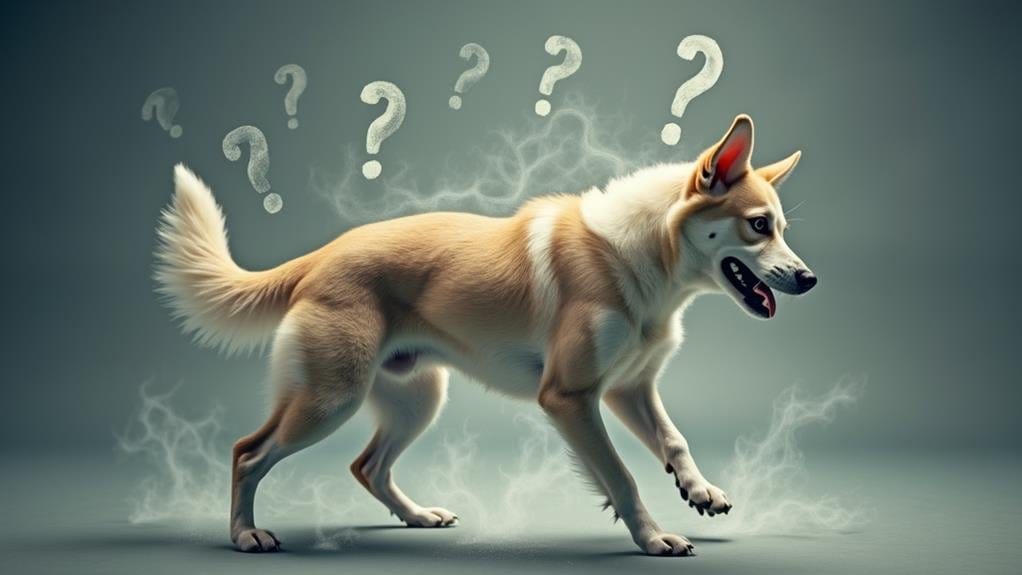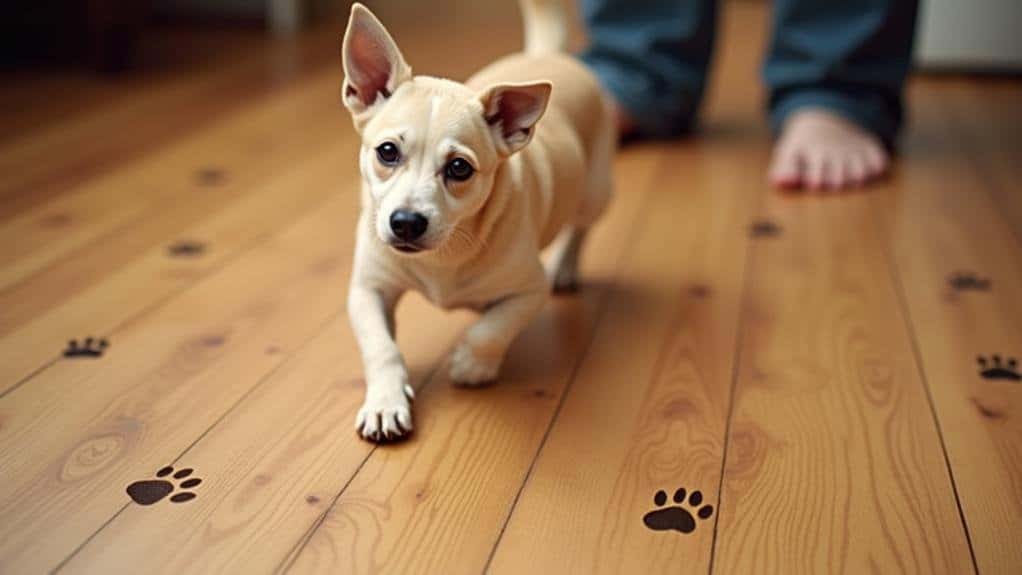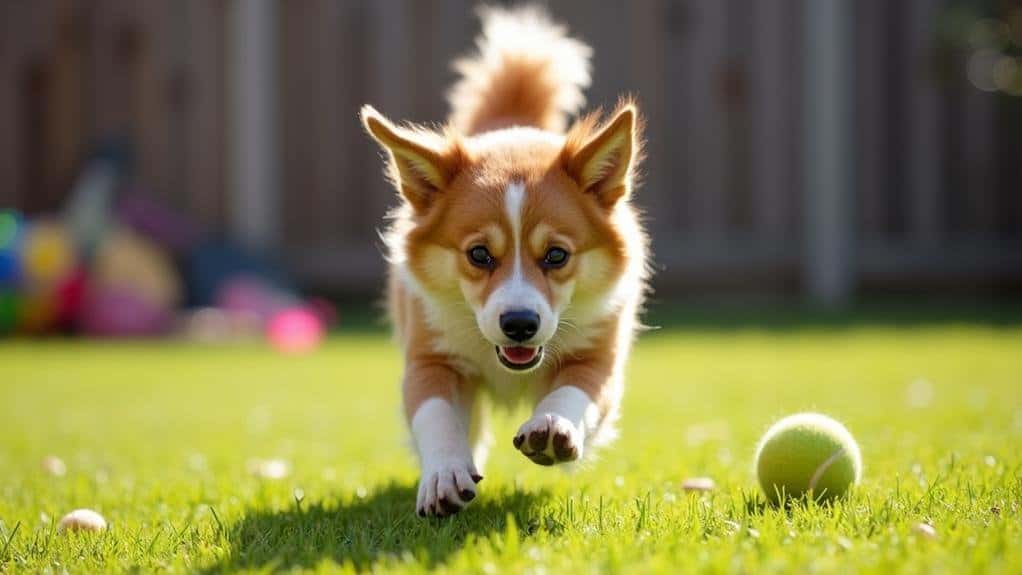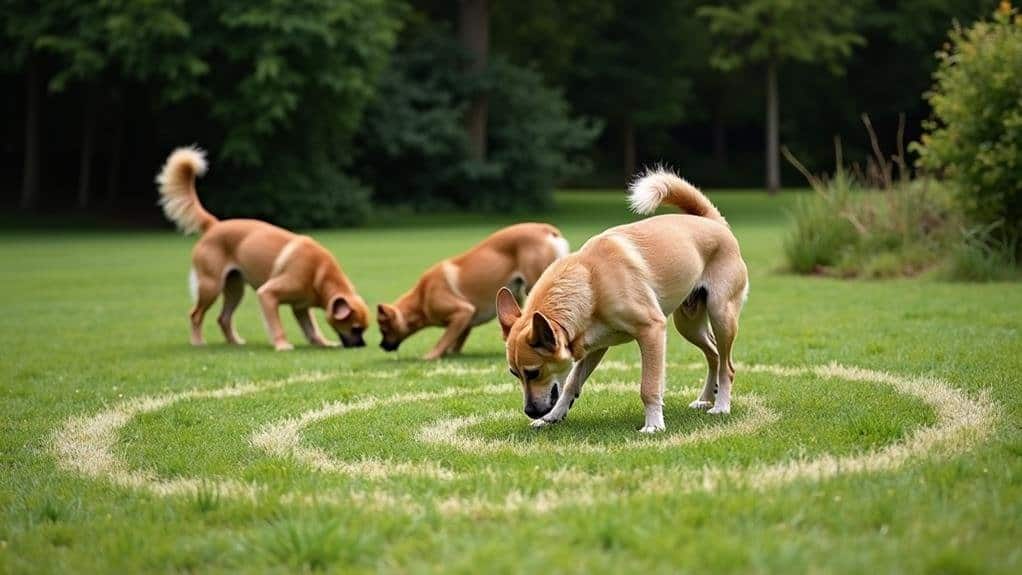Your dog's spinning behavior has multiple meanings. It can stem from instinctual roots, expressing excitement, anxiety, or serving as a pre-sleep ritual. When your pup circles, they might be surveying their surroundings, marking territory, or seeking attention. Happy spins often indicate joy, while repetitive spinning could signal stress or health issues. Medical conditions like vestibular disease or ear infections may cause excessive circling. To manage this behavior, guarantee your dog gets enough exercise and mental stimulation. If spinning interferes with daily activities or occurs suddenly, consult a vet. Understanding the nuances of this common canine behavior can provide valuable insights into your furry friend's well-being.
Instinctual Roots of Spinning Behavior

Many dog owners have observed their furry friends spinning in circles, often wondering about the origins of this curious behavior. The instinctual roots of this spinning behavior can be traced back to your dog's wild ancestors.
When you see your pet spin around before settling down, you're witnessing an ancient protective measure that helped wild canids survey their surroundings for potential threats.
This 360-degree movement isn't just a quirky habit; it's a deeply ingrained instinct that serves multiple purposes. As your dog circles, they're not only checking for danger but also releasing their scent to mark their territory.
This behavior mimics how wild dogs would establish ownership of their resting spots in nature.
For some breeds, particularly those with strong herding instincts like Collies and Australian Shepherds, you might notice more pronounced circling behaviors. This is because their natural tendencies to move in circular patterns are more deeply rooted.
Additionally, spinning can serve as an outlet for excess energy, reflecting your dog's innate drive to engage in movement and play, much like their wild counterparts would in nature.
Excitement and Playfulness

A majority of dog owners have witnessed their pets' enthusiastic spinning displays, often accompanied by wagging tails and excited barks. This behavior is a clear manifestation of your dog's excitement and playfulness, particularly when they're greeting you or anticipating a fun activity.
When your furry friend spins in circles, they're releasing pent-up energy and showcasing their joyful nature. It's their way of expressing enthusiasm and a desire to interact with you or other dogs. You'll notice this behavior is especially common when you return home or prepare for a walk.
Some breeds, like Collies and Australian Shepherds, may spin more frequently due to their herding instincts. This energetic drive translates into playful spinning during interactions.
The behavior also serves as a social engagement tool among dogs, encouraging playful interactions that mimic instinctual behaviors like chasing or circling prey.
You can identify happy spins by their prancing quality and accompanying vocalizations. These spins demonstrate your dog's emotional connection to you and their environment.
Anxiety and Stress Response

While spinning can be a sign of joy, it's not always a happy behavior. For some dogs, spinning in circles serves as a coping mechanism for anxiety and stress. If you notice your dog engaging in repetitive spinning, especially during stressful situations, it might be their way of managing internal conflict or decision-making struggles.
Dogs experiencing anxiety may exhibit more pronounced spinning behaviors, indicating a need for behavioral intervention. This repetitive motion helps them release nervous energy and regulate their emotions, but it can become problematic if left unaddressed.
To help your anxious dog, focus on creating a calm environment and providing sensory enrichment activities. These strategies can greatly reduce anxiety-related spinning.
If you're concerned about your dog's spinning behavior, consider consulting a professional for behavior modification techniques. They can help you identify triggers and develop a tailored plan to address your dog's anxiety.
Medical Conditions Causing Spinning

Manifesting as a concerning behavior, spinning in dogs can sometimes indicate underlying medical conditions that require attention. If you've noticed your dog circling excessively, it's vital to reflect on potential health issues that may be causing this behavior.
Several medical conditions can lead to spinning in dogs:
- Vestibular disease: This condition affects your dog's balance and spatial orientation, often resulting in disorientation and circling behavior. Idiopathic vestibular disease, a common form with no known cause, can occur suddenly in older dogs.
- Ear infections: Inner ear infections can impair your dog's balance and coordination, leading to excessive circling and symptoms similar to vestibular syndrome.
- Neurological issues: Brain tumors or strokes may cause spinning behavior, necessitating urgent veterinary evaluation for proper diagnosis and treatment.
- Toxin exposure or nutritional deficiencies: Certain chemicals, food poisoning, or a lack of thiamine (vitamin B1) can affect your dog's vestibular system, causing disorientation and spinning.
If you observe persistent spinning in your dog, it's imperative to consult a veterinarian promptly. They can perform a thorough examination to identify the underlying cause and recommend appropriate treatment, ensuring your dog's health and well-being.
Communication Through Circling

Dogs' circle-dancing behavior often serves as a unique form of communication. When you see your furry friend spinning, they're likely trying to convey a message. This spinning can be a way for dogs to express their emotions and intentions, both to you and to other canines.
In moments of excitement, such as before mealtime or playtime, your dog might spin to show their enthusiasm and anticipation. It's their way of saying, "I'm ready for fun!" This behavior also provides mental stimulation, helping them manage their energy levels.
For anxious or fearful dogs, spinning can act as a coping mechanism. The repetitive motion helps them deal with nervous energy and release pent-up emotions. If you notice your dog circling when stressed, they might be working through internal conflicts or decision-making struggles.
Happy spinning is often a form of greeting, showcasing the strong bond between you and your pet. It's their way of expressing joy and affection.
Additionally, this behavior can signal emotional states to other dogs, enhancing social interaction within a pack. By understanding these spinning behaviors, you'll gain valuable insights into your dog's emotional world and improve your communication with them.
Energy Release and Exercise

When your dog spins in circles, it's often a sign of pent-up energy that needs release. This behavior can indicate over-excitement or anxiety, which you can manage through proper exercise and mental stimulation.
Regular physical activity is essential for reducing hyperactivity in dogs and minimizing behaviors like spinning.
To help your furry friend release energy effectively, consider implementing these strategies:
- Daily walks or playtime sessions
- Puzzle toys for mental stimulation
- Training exercises that challenge both body and mind
- A consistent routine for exercise and play
By combining physical and mental challenges, you'll effectively channel your dog's energy, leading to a calmer and more balanced demeanor.
Establishing a regular schedule for these activities can greatly aid in behavior modification, reducing the likelihood of spinning due to accumulated energy.
Attention-Seeking Behavior

A classic canine ploy, spinning in circles often serves as an attention-seeking behavior. You may notice your dog engaging in this playful act when you're preoccupied with other tasks. It's their way of saying, "Hey, look at me!"
This spinning is a clever signal designed to prompt you into engaging or playing with them, reflecting their deep-seated need for social interaction.
Dogs spinning in circles is particularly common in high-energy pups or those who haven't received enough mental and physical stimulation throughout the day. You'll likely observe this behavior more frequently in these cases.
Additionally, your furry friend might start spinning in anticipation of rewards or activities they enjoy, such as playtime or mealtime.
Pre-Sleep Rituals

Spinning in circles before bedtime isn't just a quirky habit; it's a deeply ingrained pre-sleep ritual for many dogs. This behavior, often called "dog spinning in circles," has its roots in their wild ancestors' instincts.
When you see your furry friend performing this circular dance, they're actually engaging in a multi-purpose routine that serves several functions:
- Creating comfort: The circling motion helps your dog flatten the area they're about to rest on, making it more comfortable for sleep.
- Marking territory: As they spin, dogs release scent from their paws, effectively claiming the spot as their own.
- Enhancing security: The circular motion can help obscure visibility, giving your dog a sense of protection from potential threats.
- Stimulating digestion: This pre-sleep ritual may also help kickstart bowel movements, mimicking their ancestors' habits in the wild.
When you observe your dog spinning in circles before settling down, rest assured it's a normal and instinctive behavior.
This pre-sleep ritual is your dog's way of preparing for a safe and comfortable rest, just as their wild counterparts have done for generations.
Territorial Marking

In addition to its pre-sleep functions, a dog's circular spinning serves as a powerful form of territorial marking. When your furry friend spins in circles, they're not just preparing for a nap; they're also leaving their scent behind. This behavior is deeply rooted in their wild ancestry, where marking territory was vital for survival.
As your dog spins, they're activating scent glands located in their paws. These glands release pheromones that communicate ownership to other animals in the area. It's their way of saying, "This spot is mine!"
The act of spinning allows them to spread their scent more effectively, creating an invisible boundary that other dogs can detect. This territorial marking through spinning helps your dog establish their presence in an environment.
It's a natural instinct that makes them feel more secure and comfortable in their surroundings. By spinning and marking their territory, your dog is fundamentally creating a familiar and safe space for themselves.
When to Consult a Veterinarian

While most spinning behaviors in dogs are harmless, there are times when this seemingly innocent act can signal a more serious issue.
It's vital to recognize when your dog's circling behavior requires professional attention to identify any underlying cause and provide appropriate treatment.
You should consult a veterinarian if:
- Your dog's spinning persists for more than 30 minutes
- Circling interferes with daily activities like eating or sleeping
- Acute symptoms such as vomiting or head tilt accompany the spinning
- There's a sudden onset of spinning in a previously healthy dog
If you notice any of these signs, don't hesitate to seek veterinary care.
Persistent spinning could indicate neurological problems, while sudden changes in behavior might point to other health concerns.
For older dogs, regular check-ups are essential to monitor for age-related issues that may manifest as spinning or behavioral changes.
Frequently Asked Questions
What Does It Mean When a Dog Spins Around in Circles?
When your dog spins in circles, it's often a natural behavior. They might be checking their surroundings, expressing excitement, or managing anxiety. It's usually harmless, but excessive spinning could indicate health issues needing veterinary attention.
What Is Circling Behavior in Dogs?
Circling behavior in dogs is when you see your pet spinning around. It's often normal, linked to instincts or energy release. However, if it's excessive, you should watch for potential health issues and consult your vet.
What Is Neurological Circling in Dogs?
Neurological circling in dogs is when your pet moves in repetitive circles due to a problem with their vestibular system. It's often caused by vestibular disease, head trauma, or brain tumors. You'll notice other symptoms like disorientation or head tilting.
What Does It Mean When My Dog Runs Circles Around Me?
When your dog runs circles around you, it's typically a sign of excitement and playfulness. They're expressing joy and seeking your attention. It's their way of saying, "Let's play!" or "I'm happy you're here!"
Conclusion
You've learned that your dog's spinning behavior can stem from various causes, ranging from instinctual habits to medical issues. It's important to observe the context and frequency of this behavior. If you're concerned, don't hesitate to consult your vet. Remember, spinning can be a normal part of your dog's communication and daily routine. By understanding the reasons behind it, you'll better interpret your furry friend's needs and emotions.

